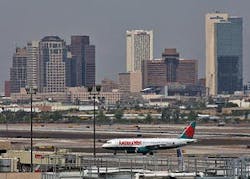America West Airline Earns Profit on Fuel, Fare Strategies
More people are flying on America West -- and at higher fares -- helping the hopeful merger partner of US Airways to a $13.9 million profit in the second quarter.
The profits beat Wall Street's expectations and were in stark contrast to the $388 million loss Delta Air Lines reported the same day. Analysts on Thursday congratulated America West on a strong quarter, highlighted by its industry-leading growth in per-unit revenue, or what it takes in to fly one seat one mile.
But many analysts are still skeptical that America West and the airline industry have broken out of a depression. Oil prices are still high, and analysts predict the increased costs will eat away at the revenue gains enjoyed this past quarter.
Analysts, on average, are predicting America West will lose 96 cents per share this quarter.
The future of US Airways, and its 5,300 employees in Charlotte, are closely linked to the health of America West. The two airlines expect their planned merger to close this fall, which they believe will create a big-enough carrier to weather high oil prices, even near $60 per barrel.
America West executives on Thursday said they are feeling the high price of oil: Jet fuel was the airline's biggest expense last quarter for just the second time in its history, at $191 million.
But America West executives are confident their revenue gains will continue. They're predicting gains in per-unit revenue this quarter to be close to last quarter's 12 percent, which was tops in the industry.
Fewer fare sales in the industry and several recent fare increases by U.S. airlines point to better revenue numbers, America West executives said.
The Arizona-based carrier filled more of its planes -- 82 percent of seats filled, up from last year's 78 percent -- and its passengers were paying more for their tickets. Revenue gains also came because it operated fewer transcontinental flights and better managed its pricing. On peak travel days, when demand for seats is high, it didn't offer its super-cheap fares, said Scott Kirby, America West's executive vice president for sales and marketing.
Another advantage America West has is its hedges on fuel, Chief Executive Doug Parker said.
Hedges allow companies to lock in prices for fuel, anticipating rises in the future. Because it had 58 percent of its fuel hedged in the second quarter, the airline was able to shave $11.3 million off its jet-fuel expenses in the second quarter.
It has 55 percent of its fuel hedged for the third quarter and 50 percent for the fourth quarter.
Delta Air Lines, fighting to stay out of Chapter 11 bankruptcy, reported a $388 million loss on Thursday for the second quarter.
Delta CEO Gerald Grinstein said Thursday that fuel prices, whether Congress bails out airline pension plans and other factors outside of management's control will help determine whether Delta joins US Airways and United Airlines in bankruptcy protection.
The earnings came a day after the abrupt resignation of Delta's CFO and its appointment of a new chief operating officer.
Other airlines announced profits on Thursday, mostly smaller and younger airlines free of the pension obligations holding down the older carriers.
JetBlue Airways Corp. met analysts' expectations with a $12.2 million profit.
Alaska Air Group made $17.4 million, besting America West's $13.9 million.
Earlier in the week, American Airlines and Continental both posted better-than-expected profits.
Northwest Airlines' mechanics appear closer to a possible strike, as the National Mediation Board released the union and airline from contract talks this week. After the mandatory 30-day cooling-off period, the mechanics would be able to strike.
Northwest says it would continue flying in the face of a strike.
